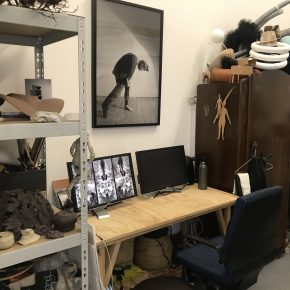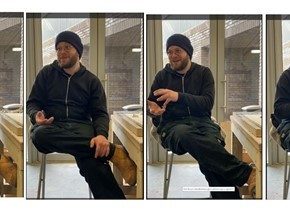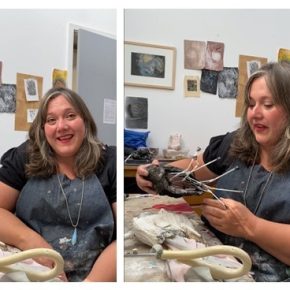Studio Conversation with Studio Holder Mella Shaw
Congratulations for been awarded one of the biggest accolades in the craft world by winning the British Ceramics Biennial Award 2023 for Sounding Line. The award comes also with a commission to create a site-specific piece for BCB 2025. Are you going to make it here as well?
Well, I would love to. It’s a brilliant opportunity for lots of people to see my work there again in two years.
When did you come to ESW?
I moved in… in February this year, I got six months for the project and then they extended that for another six months, so I’m moving out in February 2024. Although I’ve applied for a studio space and would much prefer to stay. There are so many great things about being here, but one of the main things, is having technicians who can physically help me because my work has become very big, and I want to keep making big work and I just physically can’t do it without help at some points.
You are more attracted now to bigger scale?
Not necessarily more attracted to it. I’ve just really enjoyed making it on a bigger scale. However, I’m still going to keep making things that people can hold and handle. That’s really important to me. The project that I’ve made, Sounding Line, has very big pieces, but it also has some very small pieces in it because this idea is about making people connect to something that is quite abstract, so I want people to be able to feel the emotion. Sometimes when people look at very big things, they don’t feel protective. When you have very small things, it engages you in a very different way. There’s a kind of macro micro thing going on because the whole project is about individual whales that are beaching. There’s the loss of that one whale, but it’s joined up over time that means a whole pod can die, and that means that species die out. It’s all connected, it’s a web of interconnection. That’s really the wider issue that I’m trying to explore, which is more about ecosystems and how we affect the environment and how just one or two small changes make an enormous difference.
So, what is your work about?
For me it was a very formal thing that was about tipping points. I made a lot of different works that were things that looked like they were falling, caught just before they fell. And then I realized, obviously, that I’m making work about tipping points. We are living in the most incredible time of motion of irrefutable tipping points to deal with the environment and you can’t really be an artist making work right now without being influenced by the environmental movement in some way. For me it became about more political tipping points and more environmental tipping points. Things that if we don’t listen now, we won’t be able to come back from. But still using clay. And that’s why when you look across my work, it doesn’t really necessarily look like it’s all made by the same person. But there is a continual theme.
You are a sculptor, and you use ceramic. Did you study art or craft?
None, at university I studied anthropology. I did an art foundation year, and I was going to do fine art, I got my place and everything, but I was 19 and I just felt I was too young and I knew I wanted to learn more about the world, so I went and did a degree for anthropology, specialising in anthropology of art, critical theory and material culture. After my degree, I moved into making documentaries. During that time I thought, well, I really want to use my visual instinct as well, so I wanted to marry the two, anthropology and how I could make a living. I learned how to make films, and then I moved to London and worked for years and years in museums and galleries supporting other artists on their projects. I had a long career doing that and I did enjoy lots about it and I did a lot of exhibition design. It just never felt enough and all the way through that I wanted to be making and I wanted to be making in clay, because I’d done a lot of clay work when I was a child. I was quite unhappy and I ended up just taking two week’s holiday from full time work and I did an intensive ceramics throwing class and I could already throw so I just really enjoyed it. This is when I was living in London. I went to the Diploma private view with my ceramic teacher and I couldn’t bear that other people are doing this and I’m not. So, I managed to negotiate going part time at work, and I did a two day a week course at Diploma for two years and ceramics became my whole life. I just loved it so much, and I was just desperate to do more. So, at the end of that, I applied to the Royal College of Art, and I did a two year full time Masters in ceramics and glass. Then I had to pay back the money that I borrowed to do that, so, I had to go back into full time working in museums.
How old were you when you started your Masters at the Royal College of Art?
It’s nearly ten years since I started, so, I must have been 33and 35 when I finished.
I feel happy now that I didn’t do it earlier. I’ve gone through life including some tough things before I went into making work, and I had a lot more to say, and a lot more understanding of how important it is to be in education. While I was there, I used every single minute of it, I squeezed every little bit of opportunity out of it, because I had worked so hard to get there. Now, I’m a single parent and I have very little time so, the time that I get in the studio is just super intense. I’m just throwing myself at it, I don’t waste time anymore because I feel like I’m running out. I’m 45, and I’ve got a lot of things I want to make. I definitely feel like I’ve come at it in a very convoluted way, but also because I worked in museums for years. Also, the time I spent in museums was really informative. I really understand how museums work and I understand how to display things well. I do freelance curating now as well. So, there is a lot of other skills that I learned.
How did you end up in Edinburgh? Was it work?
After I was at the Royal College of Art, I moved to Cambridge. Actually, after the Royal College of Art I got a 3 and 1/2 months fully paid residency at Konstfack in Stockholm, and while I was there, I didn’t have a job to come back to. My Masters had finished and I was living in London with my partner and she came to Stockholm, so we left London at that point. We didn’t really know where we’d be and I applied for a job at the Fitzwilliam Museum in Cambridge and she started a PhD, which was great, so we both moved to Cambridge together, and we got married. I was at the museum for three years, but I was working full time, so I was also trying to do my ceramics, but I had a really rubbish studio and it was really hard to do that as well. Then we decided we wanted to have a family. We planned for 2 years to get pregnant and I got pregnant, but then, unfortunately, my partner left. She’d had a very big breakdown and so, extremely suddenly, I was on my own and I had to raise my son on my own. Having not expected that. I didn’t have any family in Cambridge or in England, all my family are in Edinburgh, so I moved back here just for my maternity leave and then, while I was here, I got much more involved in making again. I also felt that Edinburgh was a much better place to raise kids and I had much more support here. So, for me it was really because I was a single parent.
It looks like you have a certain confidence and freedom in approaching such different projects, is this because your craft skills?
I’m really interested in making very well-crafted work. I’m not interested in making work that isn’t well made, so, for me the making is really important. But equally the idea is as important. So that’s a marriage of those two. Each project has learning curve and I hadn’t really ever built anything as big. The first form I made, I was happy with, but it needed to get better. So the ones that I’ve made subsequently are better and that’s one of the things I love about it. As soon as I can do something, I’m not that interested in doing it again and that becomes part of the project. Being an artist, I want to learn my craft and once I’ve learned how to do that, I’m not going to keep making the same thing again, because there’s no energy in that for me. I want to keep pushing my practice forward.
What is your immediate next project?
The British Ceramics Biennial is only on for six weeks, then I’m bringing that piece to Edinburgh to Summerhall and it’ll be on show from the 30 of November 2023.
I was actually in the middle of another project when Sanding Line happened. I am the current recipient of The Henry Rothschild Memorial Ceramics Bursary with a project called Rare Earth, which is about the over 60 minerals used in smart phones which are being massively depleted. So, I’m going back to the Rare Earth project, I haven’t fully finished it. I’ll use the new skills that I have built up through making work in a bigger way. I find that most of the work is in the thinking, and sometimes I just don’t get enough time to do the research and the thinking. But while I’ve been working on this project, my thinking for that other project has really developed. So, I’ve now got more nuanced ideas and feel like I’ll be able to come back and finish it with a bit more clarity, I hope. So that’s what’s going to be next.




Please, find more about Mella’s work here




